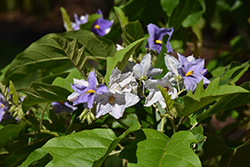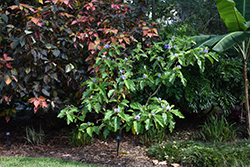It's all about ...
plants

Height: 40 feet
Spread: 30 feet
Sunlight:
![]()
![]()
Hardiness Zone: 9a
Other Names: Brazilian Potato Tree, Solanum macranthum
Description:
An exceptional tree or large shrub, offering large, colorful purple flowers that fade to lavender, then white; attractive foliage is deeply lobed with wavy margins; light gray fissured bark bears sharp thorns; plant as a specimen, or in containers
Ornamental Features
Potato Tree is blanketed in stunning clusters of lightly-scented purple star-shaped flowers with lavender overtones and yellow eyes at the ends of the branches from early spring to late fall. It has green evergreen foliage. The large spiny lobed leaves remain green throughout the winter. However, the fruit can be messy in the landscape and may require occasional clean-up. The spiny gray bark adds an interesting dimension to the landscape.
Landscape Attributes
Potato Tree is a multi-stemmed evergreen tree with an upright spreading habit of growth. Its relatively coarse texture can be used to stand it apart from other landscape plants with finer foliage.
This is a high maintenance tree that will require regular care and upkeep, and should only be pruned after flowering to avoid removing any of the current season's flowers. It is a good choice for attracting bees and butterflies to your yard. Gardeners should be aware of the following characteristic(s) that may warrant special consideration;
- Spiny
Potato Tree is recommended for the following landscape applications;
- Accent
- Shade
- Hedges/Screening
- Container Planting
Planting & Growing
Potato Tree will grow to be about 40 feet tall at maturity, with a spread of 30 feet. It has a low canopy with a typical clearance of 4 feet from the ground, and should not be planted underneath power lines. It grows at a fast rate, and under ideal conditions can be expected to live for approximately 30 years.
This tree does best in full sun to partial shade. It does best in average to evenly moist conditions, but will not tolerate standing water. This plant does not require much in the way of fertilizing once established. It is not particular as to soil pH, but grows best in rich soils. It is somewhat tolerant of urban pollution. Consider applying a thick mulch around the root zone in both summer and winter to conserve soil moisture and protect it in exposed locations or colder microclimates. This species is not originally from North America, and parts of it are known to be toxic to humans and animals, so care should be exercised in planting it around children and pets.
Potato Tree is a fine choice for the yard, but it is also a good selection for planting in outdoor pots and containers. Its large size and upright habit of growth lend it for use as a solitary accent, or in a composition surrounded by smaller plants around the base and those that spill over the edges. It is even sizeable enough that it can be grown alone in a suitable container. Note that when grown in a container, it may not perform exactly as indicated on the tag - this is to be expected. Also note that when growing plants in outdoor containers and baskets, they may require more frequent waterings than they would in the yard or garden. Be aware that in our climate, most plants cannot be expected to survive the winter if left in containers outdoors, and this plant is no exception. Contact our experts for more information on how to protect it over the winter months.
This plant is not reliably hardy in our region, and certain restrictions may apply; contact the store for more information.

